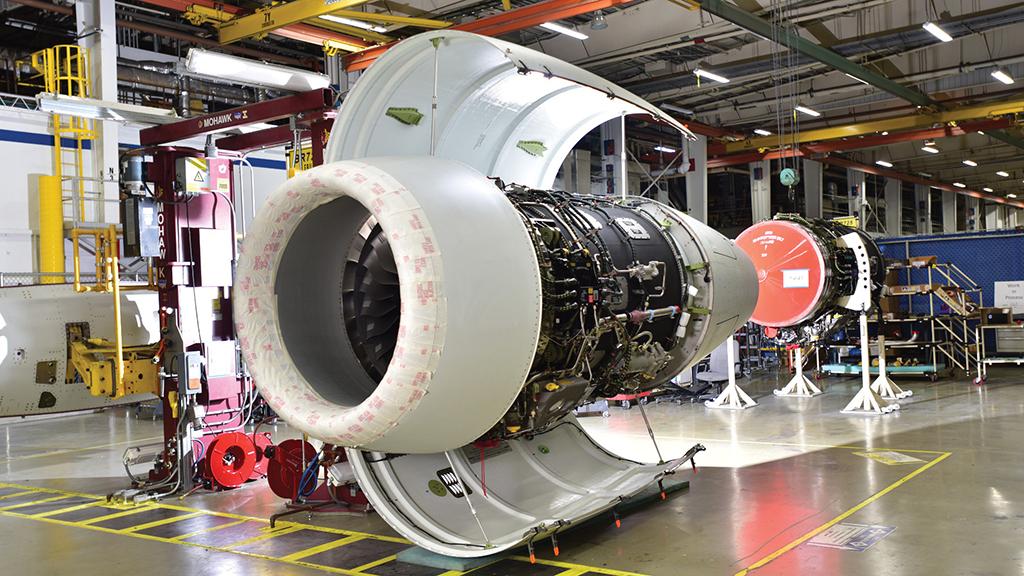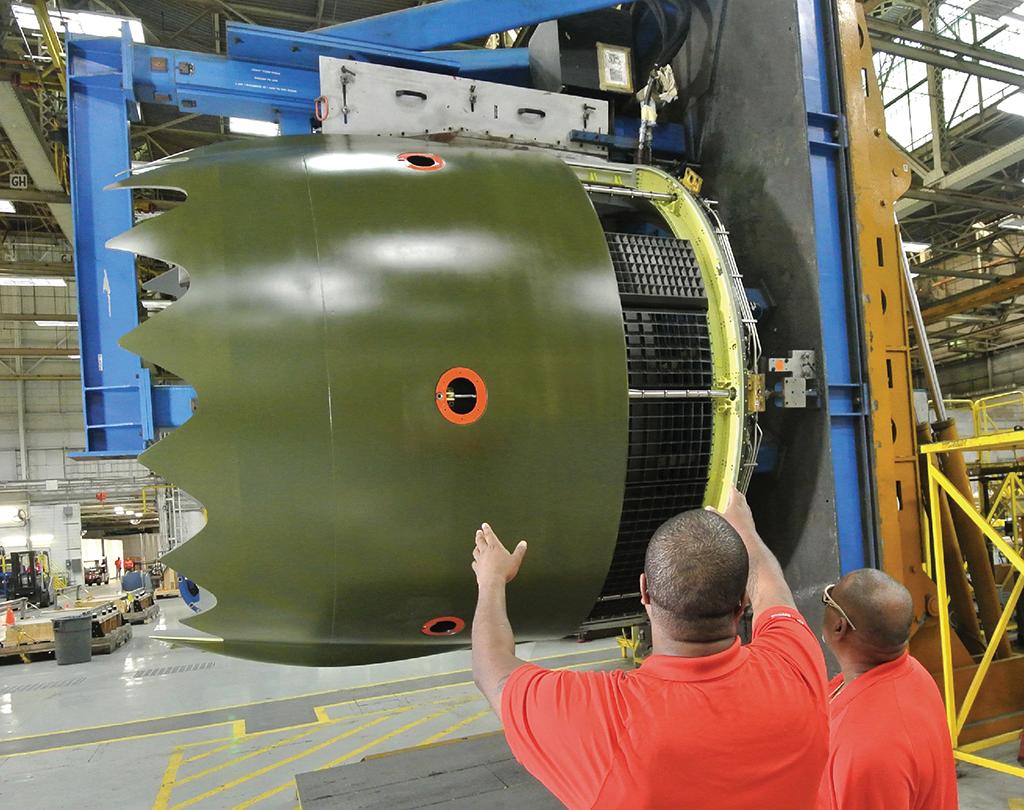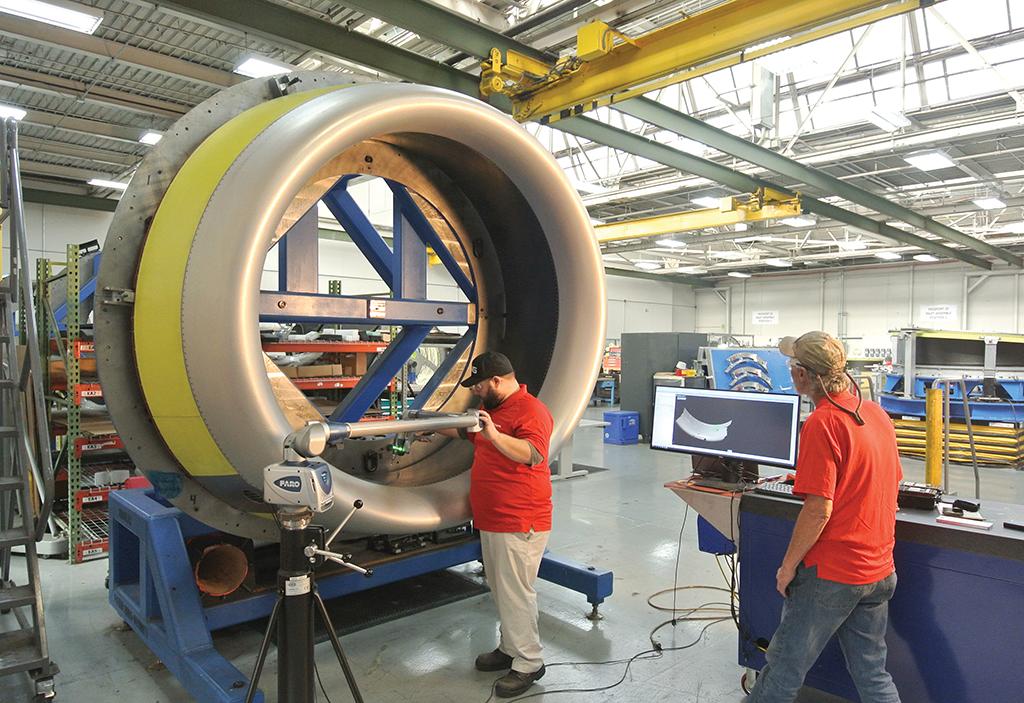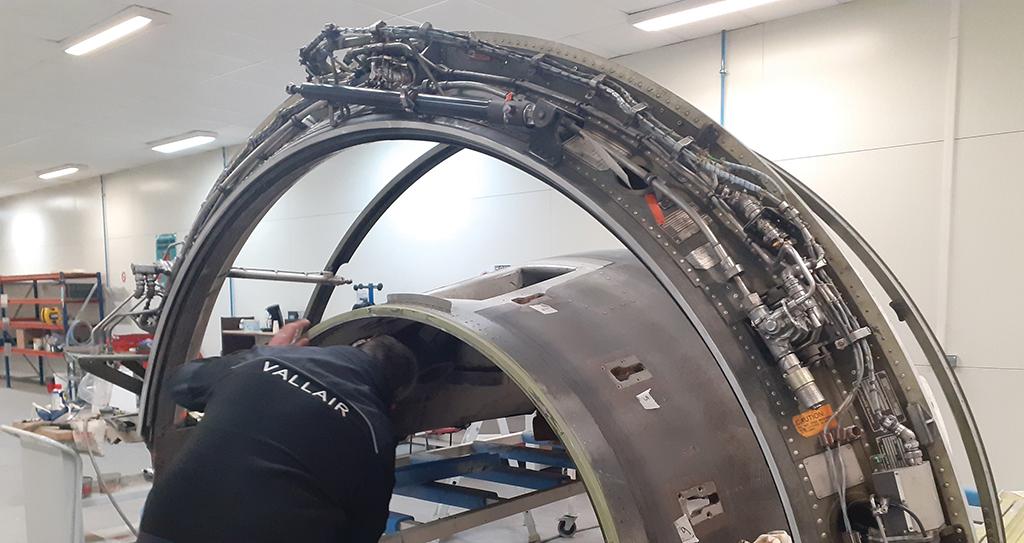Nacelle Advancements Seek Greater Durability, Sustainability

Spirit AeroSystems sees composite materials capable of withstanding higher temperatures as of particular interest for nacelle parts.
Nacelle OEMs are focusing their engineering efforts on weight and drag reduction, along with increased durability and sustainability. In fact, nacelles are high-maintenance items, especially when legacy engines are concerned.
“We see a lot of nacelle parts from [Pratt & Whitney] V2500, [CFM International] CFM56, [Rolls-Royce] Trent 700 and [Pratt & Whitney] PW4000 engines, including fan cowl doors, inlet cowls, thrust reversers, common nozzle assemblies and their component parts,” says Steve Pike, aerostructures and MRO services sales manager at Vallair. “We regularly receive for inspection nacelles with delamination of acoustic linings, corrosion, broken or worn seals, worn bearings and bushings, broken actuators, peeling of multiple paint layers and broken or cracked thermal blankets.”
Generally, nacelles consist of four basic components: the inlet, which is an aerodynamic and acoustic-critical component; fan cowl; thrust reverser; and engine exhaust system. According to Christoph Sura, product engineer for nacelles at Lufthansa Technik, composites are being applied increasingly throughout the entire nacelle assembly, especially in the inlet cowl, fan-cowl door and thrust reverser.

“Composites are the main material trend for keeping nacelle parts on wing longer, as they are much less prone to corrosion compared to metals,” he says. “However, metals such as aluminum are still used, requiring special attention to how materials are combined. For example, a decoupling of aluminum and carbon fibers prevents corrosion that would be caused by their electro-potential difference.”
OEMs see composites as key ingredients, with thermoplastic composites appearing to be the emerging materials of choice.
“Next-generation thermoplastics are the current focus for composite structures at Collins Aerospace,” says Stephane Dion, vice president of engineering and technology. “With thermoplastics, the autoclave is eliminated, the manufacturing process is cleaner and automated, and the materials can be recycled.”
Stressing Collins’ commitment to thermoplastics, he notes that in November 2021, the OEM acquired Dutch Thermoplastic Components, a Netherlands-based thermoplastics composite specialist, which Collins is combining with its Collaborative and Technology Center in Riverside, California.
Dion cites the fan cowl as one example of thermoplastic application.

“There, the objectives are lighter weight and greater robustness through the use of next-generation thermo-plastics, which are more durable,” he says. “Also, thermoplastics enable the design of seamless, fully integrated structures which minimize the number of fasteners and fittings—without multiple bolts.” Thermoplastics, Dion points out, are incorporated into the nacelles Collins has supplied to Airbus for the A320neo and Gulfstream for its new G400 business jet.
Collins also sees the thrust reverser as a candidate for architectural change, given its many moving parts and large actuation system. To address that, Dion says the OEM is moving toward fully electric actuation and away from hydraulic, for lighter weight. “With today’s high-bypass-ratio engines creating greater drag, there is less need for reverser thrust efficiency, so the design can be simplified with fewer moving parts,” he explains.
Dion notes that for the exhaust system, Collins is studying ceramics as a titanium replacement, although the lower weight will come with the material’s higher cost.
David Riordan, senior technical fellow for nacelle design and powerplant integration at Spirit AeroSystems, says reduced parts counts and increased composite use are of interest. “For all nacelle parts, composite materials capable of withstanding higher temperatures are of particular interest, since thermal and fire blankets could be reduced in thickness or potentially eliminated in certain areas,” he says.
Along this line, Riordan says the application of composite materials to components traditionally made of titanium has been employed to provide a fireproof boundary and a potential cost-reduction opportunity.
“Advanced aluminum alloys that are corrosion-resistant and can sustain a highly polished surface also represent new materials for nacelle application,” he notes.
The expanding use of composites, says Riordan, also has mitigated corrosion concerns. Nonetheless, he stresses that protective coatings for metallic components have matured to the extent that “corrosion should not be a significant concern through the lifetime of the product.”

systems. Credit: Vallair
Asked about any advances in a nacelle’s capability for containment in the event of an engine rotor failure, Riordan says that structural design analysis methods have developed to the point where the nacelle design can take into account the dynamic effects of uncontained engine-rotor failure. “In addition, the level of local structural impact damage can be minimized through the appropriate selection of materials, including ply lay-up in fabricated carbon composite components,” he says.
Looking ahead, Riordan says, with an increased focus on ultra-high-bypass-ratio (UHBR) engines, there will be greater emphasis on designing a nacelle that provides proportionate performance.
“The physical size of a nacelle for UHBR engines also places more emphasis on aerodynamic excrescence drag,” he explains. “As a result, manufacturing process technologies conducive to eliminating and/or reducing steps and gaps at structural interfaces are commanding attention.”
Thrust reversers, acting on both primary and secondary engine exhaust flows, account for “a high proportion of powerplant weight and cost,” Riordan notes. “Should engine [bypass ratio] increase further, enabling technologies for variable-pitch fans or variable-area fan nozzles could be required. The former is more attractive as a technology development, but the latter is perhaps further advanced in terms of technology readiness.”
Nacelle fabrication is also benefiting from coming technologies. As examples, Riordan points to near-net-shape manufacturing processes, such as additive-layer manufacturing, hot isostatic-pressing and hot-quench forming. “All are being pursued as potential candidates for weight- and cost-reduction,” he says.
As research continues into fossil fuel alternatives, Riordan cautions that the development of liquid-hydrogen-powered (LH2) aircraft will present new challenges for nacelle manufacturers. “Design requirements, notably those relating to fire safety, are not yet fully understood by the industry,” he says. “The interaction of systems and structure will also influence nacelle design concepts for LH2. Spirit AeroSystems is proactively investing in this area of technology development.”
Terry Vernes, director of process engineering and composite operations at Middle River Aerostructure Systems (MRAS), says the OEM has applied advanced composite materials design and analysis to the thrust reversers it provides for GE Aviation’s GEnx-2B engines, which power the Boeing 747-8. “When applied to close-tolerance, complex-nacelle assemblies, the result is a highly reliable, lightweight and acoustically efficient nacelle system,” he says.
Specifically, the thrust reverser includes a one-piece, single-cure, graphite-epoxy, inner fixed structure, which Vernes says is an improvement on the three-piece metallic and pre-cured bismaleimide structures used in previous-generation thrust-reverser designs. “The resulting concept significantly reduces weight as well as the amount of attachment hardware needed, and allows for greater ease of field repairability for a lower overall cost of ownership,” he says.
Lighter weight, less drag and reduced noise, Vernes points out, are the objectives of efforts to optimize nacelle design. As an example, he cites the nacelle MRAS has developed for the CFM Leap 1C, which powers the Comac C919 airliner, recently certified by the Civil Aviation Administration of China.
“The nacelle has a directed-flow nozzle-deicing system that more efficiently swirls engine bleed air within the inlet lip,” Vernes says. “This lowers the nacelle’s weight by reducing a significant amount of hardware [used] with the older deicing systems which utilize a piccolo tube to distribute the hot air.” He explains that the directed-flow nozzle-deicing system offers increased efficiency compared with piccolo tube systems, as well as improved maintainability due to its reduced complexity and lower amount of hardware that needs to be maintained.
Vernes says MRAS also has made “significant efforts” toward drag reduction, particularly with the nacelle—developed within the framework of its Nexcelle joint venture with Safran Nacelles—for the GE Aerospace Passport engine powering Bombardier’s long-range Global 7500 and Global 8000 business jets. He points out that this has been achieved through very tight tolerances for the nacelle’s steps and gaps, which encompass the positioning and spacing clearances between the major panels and assemblies.
“By minimizing the steps and gaps, the nacelle’s aerodynamics are optimized for reduced drag,” he says. “Additionally, there is a reduced loss of air that may escape from the airflow path through the nacelle, which improves operating efficiency.”
The nacelle components also incorporate an extensive use of composites for reduced weight, including the large two-piece fan-cowl doors that facilitate access to the engine for inspection and maintenance, along with a 360-deg., single-piece, extended inner barrel that integrates advanced acoustic protection for reduced engine noise.
Other MRAS-supplied components of the Passport nacelle are its one-piece aluminum inlet lip for reduced aerodynamic drag and an innovative anti-ice system that uses the directed-flow nozzle concept.
Noise reduction, Vernes says, is being realized through the application of acoustic treatment to composite surfaces. This includes single-degree-of-freedom liners, which are sandwich panels with a face sheet bonded to a honeycomb layer and closed by a back-skin. The double-degree-of-freedom liners are made with two core layers, composed of a top-facing-sheet, two honeycomb layers, a porous septum and a back skin. “The more interior surfaces of a nacelle that can have acoustic treatment, the better the noise reduction,” Vernes stresses.






